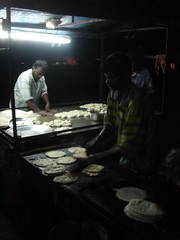

It's only 9 or so, and the only food available, really, is the food stall for drivers. We dive in.
Above, you can see men using the four food groups -- flour, ghee, water, and heat -- to make delicious Paratha, Dosas, and Chapati. We eat beans and eggs with these breads. Quite a scene, and we're basically the only foreigners eating here, which is either foolish, adventurous, or both.
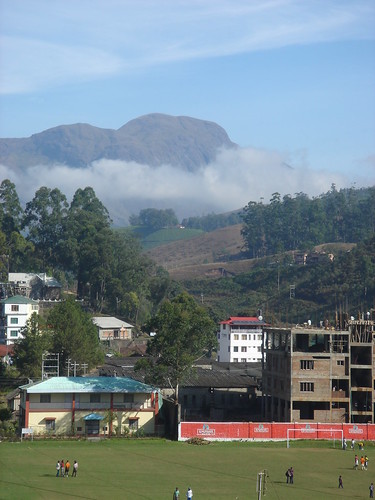
We wake up and see this. We are startled.
Our accommodation, Devonshire Hills Club, is totally surreal. I feel that we've stepped into some kind of Chronicles of Narnia like place, but with the usual Indian Masala mix of chaos, dust, and roughness. Two gardeners work every morning for hours, but the carpets in the room look every day of their twenty years, without a moment's cleaning or upkeep. It's a kind of run down YMCA facility, with a staff of at least five people doting over us. We are basically the only guests, as far as we can tell. They practically plead with us to play Billiards, Ping Pong, and eat their food. Everyone wants us to play and have a good time. Breakfast is brought to our rooms, and our cook is super eager to make us breakfast and dinner. He is always disappointed when we tell him we're not eating in his Cantina. Turns out it's a sort of country club for mid level staff of the tea plantations, accountants and so on. The managers have their own club which was the British club many years ago. We're told the tea pickers have their own club, too, though I'm doubtful, since they seem to live in long houses roofed in corrugated iron.
A huge area around Munnar is covered in tea plantations. Even Tata, the Gibson-esque, Zorastrian family owned, Indian mega corportation with holdings in everything from steel, cell phones, satellite tv, cars, has a tea plantation here. We decide to trek through some emerald green hills of tea. They go on forever. Mountains and mountains of tea. Never in our lives did we imagine we would find ourselves in a place where tea occupied a good 80% of our field of view in all directions. I suppose you could put your head into a large tea leaf filled box, and achieve a higher visual density of tea, but we think our experience might be more pleasant.
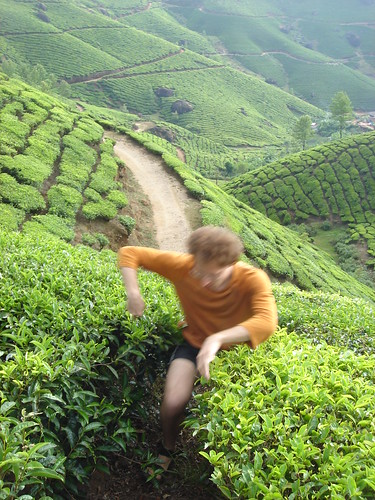
So much space, so carefully manicured -- It feels like we are in a Japanese garden, but we've been shrunk down, so we are but ants crawling through the moss of tea.
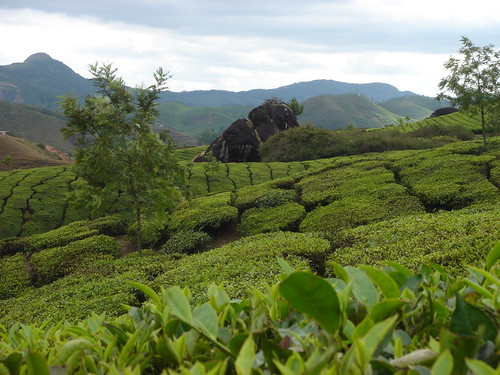
If you look at this picture above, it's a great example of Japanese garden rock placement -- the rock looks like a mountain in the distance, but it is simply a boulder in the middle ground. And you can see the real mountains in the background (which Japanese gardens don't often have), and how they aren't visually too far off from the rock in the middle ground.

Japanese gardens (see picture above) telescope this sort of space-object relationship, using even smaller rocks in the background of gardens as visual metaphors for large mountains, like this rock is doing here.
It all looks like a kind of video game level -- I want to soar through it, or roll a monkey ball down the paths. It's an extreme example of human cultivation integrating with and building upon natural beauty. The path patterns in the tea look like leaf veins -- pathways of multiple interlocking scales. My inner algorithmist perks up. The smallest pathways seem to emerge from people walking among the bushes while trying to minimize distance to all neighboring tea bush centers, and total length of paths.
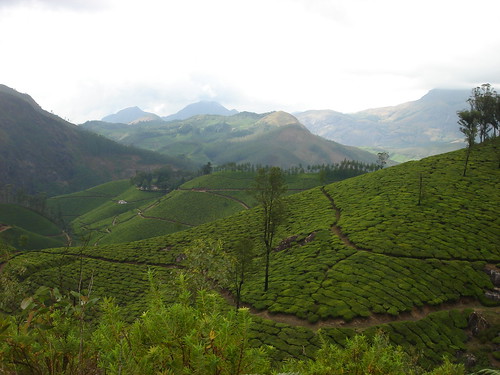
We climb up to a mountaintop, hill after hill, to see the next awesome view. Intermittently, in highly remote locations, we find lonely shrines. It's so lovely, Yotam considers withdrawing his PhD candidacy after gaining what he, and some readers have referred to as "perspective". He pens a faux letter to his department:
Dear New York University,
I have decided to withdraw my PhD candidacy.
Lying here on a tea-covered hill in Munnar
has given me a certain perspective unavailable
in New York. I apologize for any difficulty
my non-return may cause.
Sincerely,
Yotam Gingold
February 12th, 2007


Above, a picture of the kind of place the tea pickers live in. If you click into flickr, you can see more detail. Many of the people we meet in Munnar are the children of tea pickers. To the right, some children of tea pickers, returning from school, we think. The girls are standing farther back, a little bit shyer than the boys.

This is a popular resort town with Indians. Lots of newlyweds come here. We overhear, echoing through the mountains, a kind of party from a neighboring resort complete with audience singing, games, and contests. Yotam jokes that it might be a kind of ice breaker/mixer for arranged marriages: "Hello, my name is Sandeep and I love sandcastles. My name is Ranjit and I love long distance running."
We end up, tired after many hours of hiking, at a lovely British looking house with a lovely garden, the same one visible from our room window in the morning, way up in the mountains. (See first picture in this post). A woman informs us this is the manager's bungalow, and she is his wife. Alright then. We must have hiked all afternoon to get here, she tells us. Indeed. We hike another km or so down to the main road, and catch a rick back to town.
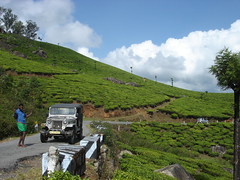
The next day we book a jeep to the (reputed) highest tea plantation in the world. It is Mr. Toad's Wild Tea Ride -- it is bumpy, and we climb dizzying heights. Some switch back turns are multi-point turns. Our driver can even talk on his cell phone while managing this. Indian drivers are truly incredible.
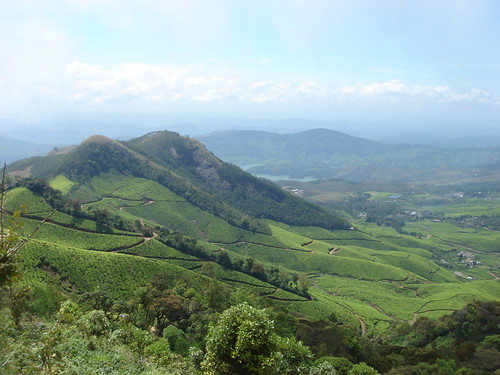
We stop at this ridiculous point at the peak of the climb. It feels like we are wandering through the tip top of a cloud scraped Chinese landscape painting.

The photo below really looks like one. Click through for more pictures of this crazy castle in the sky.
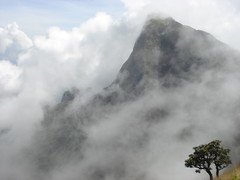
Giant clouds that would normally be sailing far overhead just roll up into our feet, and float through us, and being their slow tumble down the other side of the mountain.
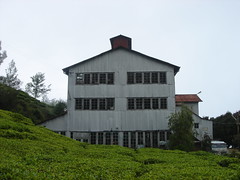
We arrive at one of the highest altitude tea plantations in the world, and one which still uses traditional processing techniques. They have no computers, either, just typewriters. Why bother? This is tea we're talking about.
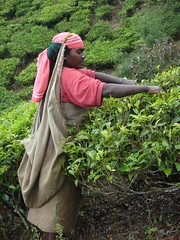
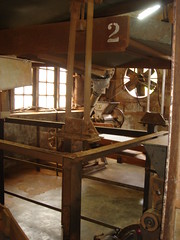
Above, a tea picker, and some machinery they use to sort tea, at one of the final stages of tea preparation. Your writer is too tired of tea and so on to narrate all 11 hundred stages of the tea processing process procedure. Rest assured that tea traditionally undergoes many stages of processing through a series of picturesque machinery before it reaches you. Click through into flickr to browse the machinery. Pretty, no?
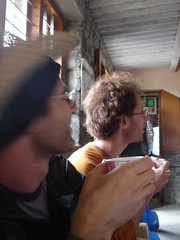
Above, Alex and Yotam, members of the tea drinking association here. Alex is wearing his usual American cowboy hat. Just as Canadian backpackers have maple leaf flags on all their stuff, American travelers should always have a cowboy hat at hand, or on head.
At the end of the day, we are exhausted, and I can't figure out why, since mostly we rode around in a jeep. I think because this was basically like riding a horse for five hours -- bumpy, and lots of core strength to balance required.
The next day we decide to see some wildlife and do a trek. Like everything on our trip, it is carefully planned in excruciating detail, at the last minute, over a late, lazy breakfast. We call ahead and are assured that we can do whatever trek we want -- just show up. Ok. After three hours of a distressingly uncomfortably and bumpy bus ride through desperately beautiful scenery, we arrive. We are tired. We see monkeys, which never ever get old. We are told that it is not, in fact, possible, that all the guides are gone, and we're about 20km from anywhere we want to be. And we just missed the last bus back in the opposite direction by 5 minutes. The next will be in three hours. Fine, we'll trek out alone! Oh no, sir, it is dangerous and not allowed. Guides are required. There are leopards, elephants, monkeys, and so on around. Fine, fine.
So, we hitchhike back with a middle aged Indian couple from Tamil Nadu, and head back up the mountain to another trekking outpost, perhaps where we should have stopped. We pass it, believing our driver had proper instructions, and not realizing that we should stop. 4km later: "Where do you want to be dropped off?" Some discussion ensues, and we get out, realize we've overshot by 4km, and we start trekking back. It is getting late, and we are hot, hungry, and tired. All of a sudden a giant open transport truck comes rushing towards us. Thinking fast, we flag it down, and hop onto the back, and hold on for our lives.
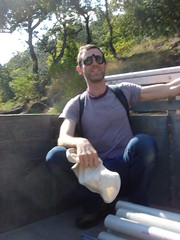
Pictured Above: Alex casually holds on to a giant truck so that he doesn't meet death or serious injury. At this point I realize: every trip should have a wild ride in an open air earth shaking multi-ton cargo truck. I mean, really. In Cambodia a few years ago, we biked from Siem Reap to Bantay Srei, which was really friggin far, and then hitchhiked, bikes and all, in a similar truck all the way home, since we were too pooped to do anything but breathe. Once the adrenalin goes, though, you have the energy to hold on, since your comfort, if not your life, seems to be at stake. This part of our trek made up for the other bad bits, and proved our adventuresome souls to all concerned.
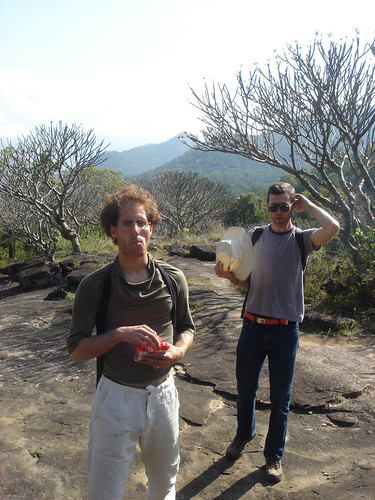
The trek afterwards was quite nice, though not as adventurous as getting to the trek. The lesson in all this is that the real trek is getting to where you want and executing plans. Actually following someone else's program -- easy.
We see footprints of leopards, guar, and so on. Some days elephants block the road for hours. Other days, like ours, we see very little. But the views are lovely, and the people are really sweet.
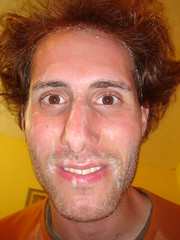
Sadly, we say goodbye to Yotam at this point. His journey with us has come to an end, and he must, in fact, go back to NYU to complete his PhD. All of here at Phases Crossed, and our readers, too, we think, will miss you. Have a great trip back!
6 comments:
Poor Yotam -- coming back to the cold and damp to work on a PhD. Reminds me of... well, me, actually. I should probably stop reading blogs and get back to work so I can hand in this draft.
OMG!! After perusing incredibly beautiful pictures and having a great adventure vicariously, I am left with that image of Yotam! How cruel!
this is my favorite entry so far... those tea fields are amazing! i'd love to see them in person. wow wow wow!
what? that picture of yotam is so cute! maybe you had to be there... it was a silly moment.
what a ...lovely... picture of tam to leave of us on. what is on his face??
I bless the Gods of tea fields, which as one non-American traveler once remarked to me, "look a lot like west virginia."
hmm
hey chaim, first time checking in on your blog... what an amazing journey! i'm inspired to travel after my work is done.
Post a Comment